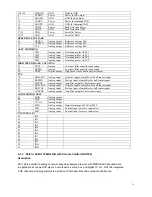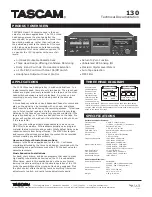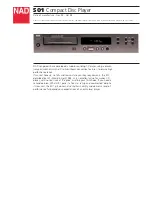
3
(3) The components used in the unit have a specified flame
resistance and dielectric strength.
When replacing components, use components which
have the same ratings, by (
) or by (
) in the
circuit diagram are important for safety or for the
characteristics of the unit. Always replace them with
the exact replacement components.
(4) An insulation tube or tape is sometimes used and some
components are raised above the printed wiring board
for safety. The internal wiring is sometimes clamped
to prevent contact with heating components. Install
such elements as they were.
(5) After servicing, always check that the removed screws,
components, and wiring have been installed correctly
and that the portion around the serviced part has not
been damaged and so on. Further, check the insulation
between the blades of the attachment plus and
accessible conductive parts.
1-2-2 Insulation Checking Procedure
Disconnect the attachment plug from the AC outlet and
turn the power ON. Connect the insulation resistance meter
(500V) to the blades of the attachment plug. The insulation
resistance between each blade of the attachment plug and
accessible conductive parts (see note) should be more than
1 Megohm.
Note:
Accessible conductive parts include metal panels,
input terminals, earphone jacks, etc.
1-3 ESD Precautions
Electrostatically Sensitive Devices (ESD)
Some semiconductor (solid static electricity) devices can
be damaged easily by static electricity.
Such compo9nents commonly are called Electrostatically
Sensitive Devices (ESD). Examples of typical ESD devices
are integrated circuits and some field-effect transistors and
semiconductor chip components. The following techniques
of component damage caused by static electricity.
(1) immediately before handling any semiconductor
components or semiconductor-equipped assembly,
drain off any electrostatic charge on your body by
touching a known earth ground. Alternatively, obtain
and wear a commercially available discharging wrist
strap device, which should be removed for potential
shock reasons prior to applying power to the unit
under test.
(2) after removing an electrical assembly equipped with
ESD devices, place the assembly on a conductive
surface such as aluminum foil, to prevent electrostatic
charge buildup or exposure of the assembly.
(3) Use only a grounded-tip soldering iron to solder or
unsolder ESD device.
(4) Use only an anti-static solder removal devices. Some
solder removal devices not classified as “anti-static”
can generate electrical charges sufficient to damage
ESD devices.
(5) Do not use freon-propelled chemicals. These can
generate electrical charges sufficient to damage ESD
devices.
(6) Do not remove a replacement ESD device from its
protective package until immediately before you are
ready to install it. (Most replacement ES devices are
packaged with leads electrically shorted together by
conductive foam, aluminum foil or comparable
conductive materials).
(7) Immediately before removing the protective materials
from the leads of a replacement ES device touch the
protective material to the chassis or circuit assembly
into which the device will be installed.
CAUTION:
Be sure no power is applied to the chassis or
circuit, and observe all other safety precautions.
(8) Minimize bodily motions when handling unpackaged
replacement ESD devices. (Otherwise harmless
motion such as the brushing together of your clothes
fabric or the lifting of your foot from a carpeted floor
can generate static electricity sufficient to damage an
ESD device).
Summary of Contents for DVD-636
Page 1: ...MTK1379SOLUTION MODEL DVD 636 DVD PLAYER...
Page 9: ...7 Pinout Diagram...
Page 30: ...28 6 Disassembly and Reassembly...
Page 40: ...38...






































